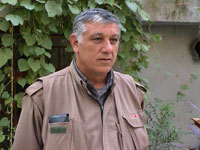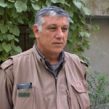Leading PKK Commander Cemil Bayik Crosses into Iran
Publication: Terrorism Focus Volume: 5 Issue: 20
By:

On May 10, the Turkish General Staff posted a press release on its web site which stated: “As a result of the Turkish air strike on the Qandil Mountains, a senior PKK commander, Cemil Bayik, fled into a neighboring country together with a large group of PKK members, engaging in clashes with local security forces” (tsk.mil.tr). The release did not name the neighboring country, but it appears to be Iran. Cemil Bayik’s decision to flee into Iran has significant implications for the PKK’s leadership as well as Turkey’s efforts to eliminate the PKK from northern Iraq.
Cemil Bayik was born in 1951 in Hazar in the province of Elazig. He attended the Faculty of Language and Literature at the University of Ankara, where he met Abdullah Ocalan, the currently imprisoned leader of the PKK. Bayik is one of the five founders of the PKK who are still alive and is noted for his loyalty to Ocalan. To prove his fidelity to Ocalan he relentlessly executed PKK members who broke the rules of the organization. A former high-ranking PKK member, Hidir Sarikaya, thinks that approximately 300 PKK members have been executed by Cemil Bayik since the 1980s (Cumhuriyet, November 24, 2007).
Despite this apparent loyalty, Abdullah Ocalan’s opinion of Cemil Bayik is not overly positive. Ocalan has criticized Bayik’s military leadership and ability to direct a guerrilla movement. According to Ocalan, Bayik prefers to stay behind the frontlines and has become involved in several controversial cases. For instance in 1992, fearing capture by the Turkish security forces, Bayik killed 17 wounded PKK militants in a cave (Abdullah Ocalan’s testimony before the State Security Court, 1999; belgenet.com).
Cemil Bayik is currently one of the 12 leaders of the executive council of the Kurdistan Democratic Confederation (Koma Civaken Kurdistan, or KCK), the umbrella organization bringing together the PKK and the Party for a Free Life in Kurdistan (PJAK), an offshoot of the PKK fighting against Iran. In the 1990s he served as the leader of what was then the PKK’s military wing, the People’s Liberation Army of Kurdistan (Arteshen Rizgariya Gelli Kurdistan, or ARGK) (Tempo [Istanbul], October 18, 2007).
Bayik’s leading role in the organization became visible when he and Murat Karayilan, acting head of the PKK, teamed up on the side of traditionalists against reformists within the organization. As a result of the internal conflict, the reformists decided to leave the organization in 2003. These figures included those who occupied important positions in the PKK, such as Kani Yilmaz, former PKK representative in Europe who was assassinated in northern Iraq in 2006, Nizamettin Tas and Osman Ocalan (Abdullah Ocalan’s brother). Bayik and Karayilan issued a declaration stating: “Some among us have betrayed the cause by leaving the organization on the grounds of politicization. The arms will never be laid down; we always will be prepared. Those who left the organization with the money distributed [to the PKK] now live in Beirut, seeking the mercy of the United States” (Aksiyon [Istanbul], March 8, 2004).
During this period, Cemil Bayik was the apparent number two person in the PKK. However when Fehman Huseyin, a Syrian-born Kurd, became the head of the PKK’s military wing, the Peoples’ Defense Force (Hezen Parastina Gel, or HPG), in June 2004, Bayik found himself in limbo between the positions occupied by Murat Karayilan on the one hand and Fehman Huseyin on the other (www.hpg-online.net).
Former PKK Commander Semdin Sakik thinks that Bayik is a poor commander but is quite able at diplomacy and training new PKK cadets [1]. Perhaps his decision to cross from the Qandil Mountains to the Iranian side of the border is related to his diplomatic skills, as Bayik is the person who manages the PKK’s connections within Iran (Tempo, October 18, 2007). This would not be the first time Cemil Bayik went to Iran—it was reported in April 2002 that Bayik had crossed to Iran the previous month (NTV, April 3, 2002). Similarly, Turkey’s ambassador to Tehran, Selahattin Alpar, declared: “We have official information that Cemil Bayik is in Iran. We requested from Iranian authorities to arrest and hand him over to Turkey” (Zaman, April 4, 2002). However, Tehran did not confirm the Turkish intelligence about Bayik’s presence in Iran. According to Turkish press reports, Iran declined to hand Bayik over to Turkey because the PKK threatened the Iranian authorities with organizing Iranian Kurds to ignite an armed struggle against the Iranian regime in the event Tehran cooperated with Ankara (Aksam, April 6, 2002).
In a 2006 interview, Bayik outlines how he views the Kurdish policies of Turkey, Iran and the United States. Bayik suggests that Iran, Turkey, and Syria signed a cooperation pact in 2005 against the PKK. Iran’s aim in this cooperation is to keep Turkey on its side against the United States. The United States, Bayik argues, does not want Turkey to side with Iran and Syria; thus, it aids Turkey against the PKK (Ozgur Gundem, May 9, 2006).
A year later, however, Bayik retreated from his comment on Iranian cooperation against the PKK and argued: “When U.S. President Bush declared the PKK as the enemy of the United States, it clearly indicated that Turkey, Iraqi Kurds, and the United States agreed to purge the PKK. They want us to declare a ceasefire and lay down our arms without any precondition. They obviously [want to] force us to surrender. To lay down arms would destroy us and they want this to happen” (Ozgur Gundem, November 21, 2007).
In this light, perhaps, Cemil Bayik considers camps in northern Iraq to no longer be safe. It was reported that the PKK built new bunkers on top of the Iranian side of the Qandil Mountain range that are as deep as fifty meters (Aksam, May 14). Bayik’s entry into Iranian territory could be related to the construction of these new bunkers—after the first Turkish bombing of the Qandil Mountains in December 2007, Bayik did not visit his traditional hideout in Urumiye, Iran (Yeni Safak, December 28, 2007). Although the Turkish parliament passed a memorandum allowing Turkish troops to strike PKK camps in Iraq, the same memorandum does not allow the Turkish military to operate within Iranian territory. Under this circumstance, the safest place for Cemil Bayik is the Iranian side of the Qandil Mountains.
Given his earlier connections within Iran, it was not surprising for Cemil Bayik to flee there when Turkish air strikes against PKK formations in the Qandil Mountains resumed in the first days of May. What is surprising, however, is Iranian security forces’ decision to clash with Cemil Bayik and his militants who previously entered into Iranian territory multiple times without major problems. The reason for the change in Iranian policy, perhaps, is Turkey’s prior notification to Iranian authorities of Turkish operations against the PKK. The Turkish daily Hurriyet reported that Turkey shared the coordinates of Turkish F-16 jets with Iranian authorities before the latest operation started (Hurriyet, May 14).
Based on the information Turkey shared with Iran, Iranian authorities might try to counter Cemil Bayik’s entry into Iranian territory. Iran’s decision to fight against Bayik indicates that Tehran does not distinguish the PKK from PJAK. If Iran’s new policy is to consider the PKK as its enemy, it will limit the PKK’s ability to operate beyond the Iranian border. At this point it is unlikely, but further developments may lead the Turkish and Iranian militaries to conduct joint operations against the PKK within Iranian territory.
Notes
1. Semdin Sakik, Apo (Istanbul: Sark Yayinlari, 2005), 65




